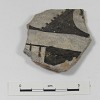
| Culture | Branch | Tradition | Ware | Type |
| Ancestral Pueblo: Southern Colorado Plateau (Anasazi) | Central Anasazi | Northern San Juan | Northern San Juan White Ware | Cortez Black-on-white |
Type Name: Cortez Black-on-white |
|
| Period: | 880 A.D. - 1050 A.D. |
| Culture: | Ancestral Pueblo: Southern Colorado Plateau (Anasazi) |
| Branch: | Central Anasazi |
| Tradition: | Northern San Juan |
| Ware: | Northern San Juan White Ware |
First posted by C. Dean Wilson 2103
Cortez Black-on-white was defined by (Abel 1955). This type refers to white wares exhibiting styles and attributes indicative of forms produced in the Northern San Juan region during the Early Pueblo II period (Breternitiz and others 1974; Oppelt 1992; Wilson and Blinman 1995). Cortez Black-on-white is similar to Naschitti Black-on-white, Newcomb Black-on-white, Red Mesa Black-on-white, and early forms of Arboles Black on white. Cortez Black-on-white is usually well-polished and commonly exhibits a white sometimes crackled slip. Rims are rounded and tapered and can be solidly painted or unpainted. Decorations are almost always applied in a mineral pigment that may be black or brown and sometimes red. The range of vessel forms is wider than that noted for earlier types and includes bowls, jars, seed jars, and dippers.
Cortez Black-on-white incorporates a number of distinctive design motifs which often occur together in complex combinations that fill most of the space in the painted potion of the vessel. Motifs include sequences of thin parallel lines, solid triangles that are often ticked, scalloped or stepped, square and diagonal checkered patterns, wavy lines, ticked lines, and rick rack. Bands may be filled by squiggle hachure, interlocking scrolls, or stepped and ticked triangles. Bands filled with straight or squiggle hachured designs are sometimes assigned to Mancos Black-on-white rather than Cortez Black-on-white. A partitioned or banded layout is often present in where the vessel decorations divided into a series of two to four geometrically opposed sections. Each section consists of similar combinations of design motifs separated by a succession of thin framing lines. The earliest associations of Cortez Black-on-white pottery is with assemblages dating to the late ninth century or the late Pueblo I period. Cortez Black on-white is the dominant white ware type in assemblage sin the Northern San Juan region through the tenth century. Mancos Black-on-white begins to replace Cortez Black-on-white about A.D. 1000, and the replacement is complete by about A.D. 1050.
References:
Abel, Leland J.
1955 San Juan Red Ware, Mesa Verde Gray Ware, Mesa Verde White Ware and San Juan White Ware, Pottery Types of the Southwest: Wares 5A, 10A, 10B, 12A. Museum of Northern Arizona Ceramic Series 3B, Flagstaff.
Breternitz, David A., Arthur H. Rohn, Jr., and Elizabeth A. Morris
1974 Prehistoric Ceramics of the Mesa Verde Region. Museum of Northern Arizona Ceramic Series 5, Flagstaff.
Oppelt, Norman T.
1992 Earth Water Fire: The Prehistoric Pottery of Mesa Verde. Johnson Books, Boulder.
Wilson, C. Dean
1996 Ceramic Pigment Distributions and Regional Interaction: A Re-examination of Interpretations in Shepard's "Technology of La Plata Pottery". The Kiva 62(1):83-102.
Wilson, C. Dean, and Eric Blinman
1995 Ceramic Types of the Mesa Verde Region. In Archaeological Pottery of Colorado: Ceramic Clues to the Prehistoric and Protohistoric Lives of the State's Native Peoples, edited by R.H. Brunswig, B. Bradley, and S.M. Chandler, pp. 33-88. Colorado Council of Archaeologists Occasional Papers 2, Denver.
Related Photos
 © New Mexico Office of Archaeological Studies, a division of the New Mexico Department of Cultural Affairs.
© New Mexico Office of Archaeological Studies, a division of the New Mexico Department of Cultural Affairs.
The Center for New Mexico Archaeology
7 Old Cochiti Road
Santa Fe, NM 87507
505-476-4404
Fax: 505-476-4448







